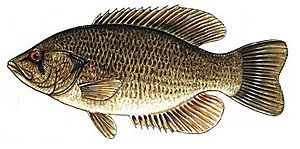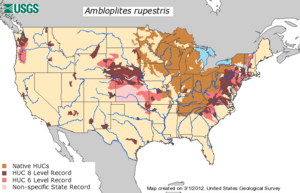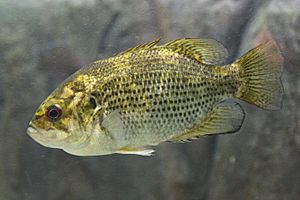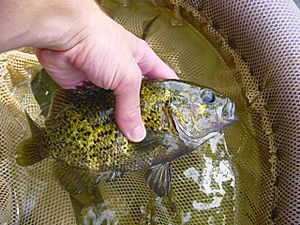Rock bass facts for kids
Quick facts for kids Rock bass |
|
|---|---|
 |
|
| Rock bass | |
| Conservation status | |
| Scientific classification | |
| Synonyms | |
|
The rock bass (Ambloplites rupestris) is a cool freshwater fish found in east-central North America. People also call it the rock perch, goggle-eye, or red eye because of its bright red eyes! It's part of the sunfish family. You can tell a rock bass apart from other sunfish because it has six spines on its anal fin. Most other sunfish only have three.
Contents
Where Do Rock Bass Live?
Rock bass are originally from the St. Lawrence River and Great Lakes area. They also live in the upper and middle parts of the Mississippi River basin in North America.
You can find them from Quebec to Saskatchewan in the north. They live as far south as Missouri and Arkansas. In the eastern U.S., they are found from New York down through Kentucky and Tennessee. They also live in northern Alabama, Georgia, and Florida. Rock bass have even been seen in the Nueces River system in Texas.
What Does a Rock Bass Look Like?
Rock bass look a bit like smallmouth bass, but they are usually much smaller. Here are some ways to spot a rock bass:
- They have two dorsal fins (back fins) that are joined together.
- They have a large mouth.
- They have six spines on their anal fin (bottom fin).
- Their eyes are red!
- They have rows of dark dots on their sides.
Their mouth is at the front of their head, below their snout. It has small, cone-shaped teeth for eating prey. Most rock bass are between 6 and 10 inches long. They rarely weigh more than one pound.
The biggest rock bass ever recorded was about 17 inches long. It weighed around 3 pounds. These fish can live for up to 10 years. Rock bass can change their body color quickly. They can go from golden brown to olive, with a white or silver belly. This helps them blend in with their surroundings.
Rock Bass Habitat
Rock bass like clear water with rocks and plants. They often live in stream pools and along the edges of lakes. You can find them near rocky banks in lakes and reservoirs in the northeastern U.S.
Their favorite places have some plants, rocky bottoms, and cool to warm water. They are often found close to rocky shorelines. Rock bass can be surprisingly calm around people. They might even live under docks or near swimming areas. You often see rock bass in groups, especially near other sunfish.
What Do Rock Bass Eat?
Young rock bass can be eaten by larger fish like big bass, northern pike, muskie, and walleye. Rock bass also compete with smallmouth bass for food.
Rock bass are carnivores, meaning they eat meat. Their diet includes:
- Smaller fish (sometimes even their own young!)
- Yellow perch
- Minnows
- Insects
- Crustaceans (like crayfish)
Sometimes, rock bass will even eat food from the surface of the water. Adult rock bass eat a lot, especially in the evening and early morning.
Conservation Efforts
Rock bass are doing well in their natural homes. They are listed as a species of "least concern" by the IUCN. This means their population is stable. They do not need any special monitoring or plans to protect them.
Since rock bass are popular for fishing, their populations are managed by fishing rules. Some places have "slot limits" for rock bass. This means you can only keep fish that are a certain size. Also, special nursery ponds are used to help keep rock bass populations healthy.
Rock Bass Reproduction and Life Cycle
Rock bass are ready to have babies when they are about 2 to 3 years old. During breeding season, both male and female rock bass can have multiple mates.
They lay eggs from April to early June. This happens in warm water, usually between 12 and 15 degrees Celsius. A female can lay anywhere from 2,000 to 11,000 eggs!
Like other sunfish, the male rock bass digs a nest in the shallow parts of the lake. He then guards it very strongly. Many rock bass nests might be close together in one spawning area. Because of this, males can become quite aggressive. They try to defend their space and attract females.
Rock bass don't have special courtship dances. The female just enters the nest and swims in circles with the male. Both the female and male release their eggs and sperm into the nest at the same time. The male then guards the eggs and fans them with his fins. He also takes care of the young fish for a short time after they hatch. Rock bass are known to grow quickly!
Rock Bass and Humans
Rock bass are considered a fun fish to catch in many places. The world record for the biggest rock bass ever caught is 3 pounds. This record is shared by two fish: one caught in Ontario, Canada in 1974, and another in Pennsylvania, USA in 1988.
Misconceptions About Rock Bass
Sometimes, people get rock bass confused with other fish. For example, the Ozark bass (Ambloplites constellatus) and the shadow bass (Ambloplites ariommus) are true rock bass, but they are different species.
In Canada, Ambloplites rupestris is sometimes called the "redeye" or "redeye bass." However, this name usually refers to a different fish called the Micropterus coosae. That fish is a type of centrarchid that lives in parts of the Southern United States.
- FishBase: Ambloplites rupestris
- ITIS: Ambloplites rupestris
See also
 In Spanish: Ambloplites rupestris para niños
In Spanish: Ambloplites rupestris para niños






